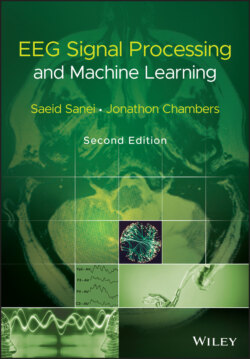Читать книгу EEG Signal Processing and Machine Learning - Saeid Sanei - Страница 29
2.5 Emotions
ОглавлениеThe brain right hemisphere is associated with emotions. Lateralized electrophysiological parameters measured during emotionally charged states found relative activation (as measured by decreased alpha power) using EEG during the recollection of past events associated with anger or relaxation. Similar findings were obtained during self‐reported emotional reactions to visual material [26]. Other experimental studies have verified the relative right‐hemisphere activation when participants were asked to generate emotional imagery [27], and during hypnotically induced depression [28]. More recent quantitative EEG research has demonstrated reliable relationships between the magnitude of cerebral activation and the intensity of emotional arousal [29]. In related research, the ages of emotional memories correlated with the magnitude of activation using quantitative EEG [30]. Most of these studies conclude from the asymmetry in the activities of lateral brain lobes [31].
Perhaps the strongest evidence in support of the valence hypothesis was derived from a plethora of EEG studies that have associated relative increased left‐hemisphere activity with positive emotional states and relative increased right‐hemisphere activity with negative emotional states such as in [32]. Frontal EEG shows relative left‐hemisphere activity during a positive emotional response, whereas the opposite pattern is displayed during a negative emotional response.
Some recent machine learning applications [33] have shown that the ratio between the power of EEG in the beta band and the theta band and their asymmetry is associated with change in emotions.
In [34] the authors have shown that six features namely, power spectral density (PSD), differential entropy (DE), differential asymmetry (DASM), rational asymmetry (RASM), asymmetry (ASM), and differential causality (DCAU) features from EEG, are associated with emotions and can be classified for emotion recognition.
Further unpublished research has focused on brain connectivity for emotion recognition. The patterns of interdependency between different brain regions for emotional and non‐emotional film stimuli from EEGs have been analyzed and the emotion‐related differences evaluated. A simple measure of synchronization index (SI) has then been used to detect interdependencies in EEG signals mainly for happiness and sadness. The SI significantly changes/increases during emotional stimulation and, in particular, during sadness, yielding an enhanced connectivity among frontal channels. Conversely, happiness is associated with a wider synchronization among frontal and occipital sites, although happiness itself was less synchronized [35].
